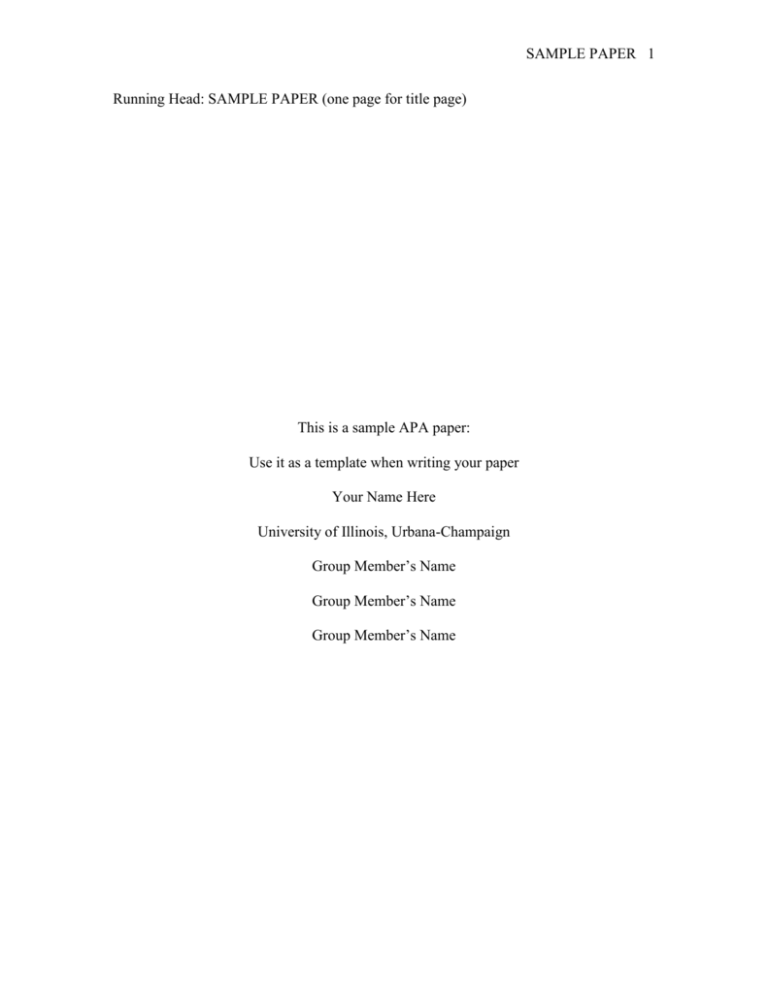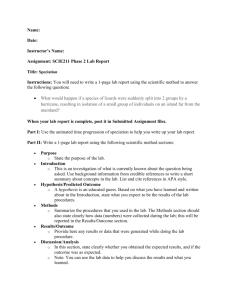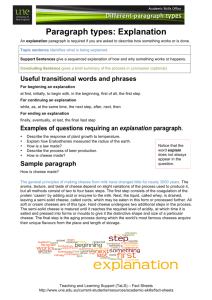APA Paper Template: Sample for Students
advertisement

SAMPLE PAPER 1 Running Head: SAMPLE PAPER (one page for title page) This is a sample APA paper: Use it as a template when writing your paper Your Name Here University of Illinois, Urbana-Champaign Group Member’s Name Group Member’s Name Group Member’s Name SAMPLE PAPER 2 Abstract (one page for abstract) This is where you put your abstract. Your abstract is approximately 120 words. The first line is not indented. The abstract is single-spaced. It states what you did, how you did it, what you found, and gives a brief summary of your discussion. Throughout an APA style paper there is only one space after periods. Do not start your abstract with the words “This study” under any circumstances. SAMPLE PAPER 3 The title of your paper goes here (bolded & single spaced) Now you start the text of your paper. This first section is your introduction (2-3 pages). This is all double-spaced. The first line of each paragraph is indented. At the end of your intro you want to have a summary section that repeats the main goal of your study and then lists each of your hypotheses. SAMPLE PAPER 4 Methods (about 1 page for methods) Participants. Give the total number of participants. Describe your sample a bit (mostly college age, all students in a research methods class at UIUC, etc.). If you had to throw out any of the data for any reason, state why and then give the corrected sample size. Materials. Here is where you describe your measures. If you used a pre-existing questionnaire you will want to cite the authors, describe the measure and response format, give a sample item, and give the reliability. If you made everything yourself, just describe what the measure was and list all items in the Appendix at the end of your paper. If we created groups from some continuous variable (e.g., all the people who really, really love ironing their socks vs. those who don’t) now is the time to mention that and say how many people were in each of those groups. Procedure. Describe exactly what your participants (and raters if applicable) did. What was the format of your questionnaires? How long did it take them? etc. SAMPLE PAPER 5 Results (~1 page for results) Here is where you write what was annotated from your output. You should refer to figures rather than writing out means. PLEASE REMEMBER ONLY TO USE TWO DECIMAL PLACES. Using a number like this 4.3335234526454326 is bad. Just write 4.33. You should list your results by first going over any results that relate to your hypotheses. So, if you have a hypothesis that was not supported say that “contrary to expectations, the hypothesis was not supported”. If you have any questions on how to figure out if a hypothesis was supported or not, just let me know. If you have a hypothesis that was supported state that, as hypothesized, the effect did happen and give your statistics, as shown in Figure whatever. You will want to finish your results section with any unpredicted results or findings. This section will probably not be more than one page. SAMPLE PAPER 6 Discussion (2-3 pages) The first step is to summarize your results. Think of this as a summary of your results that even my grandmother could understand. Plain English folks, nothing fancy here. (ex.: “This study found that women like cheese more than men like cheese.”) Be sure to be clear, we do not want my grandmother to think that women like cheese more than they like men. Second, talk about what your findings mean. You can relate this back to previous research, the real world, your cat, whatever, just make it believable. This is a great time to talk about any unexpected findings and relate them to other lines of research and get those numbers in your reference section up. Limitations and Future Directions. Third, you will want to talk about the limitations and future directions of your study. Number of participants is a good one here. Think about how to take this out in the real world, how to manipulate it in the lab, etc. Finally, give a general summary of your study in a sentence or two maybe with a comment on how your study will impact the world. SAMPLE PAPER 7 References Journal 2 authors, one main title: Baerger, D. R., & McAdams, D. P. (1999). Life story coherence and its relation to psychological well-being. Narrative Inquiry, 9, 69-96. Journal lots of authors, one main title with subtitle: Campbell, J. D., Trapnell, P. D., Heine, S. J., Katz, I. M., Lavallee, L. F., & Lehman, D. R. (1996). Self-concept clarity: Measurement, personality correlates, and cultural boundaries. Journal of Personality & Social Psychology. 70, 141-156. Book chapter with 2 editors and one author: Emmons, R. A. (2003). Personal goals, life meaning, and virtue. In C. L. M, Keyes & J. Haidt (Eds.), Flourishing: Positive psychology and the life well-lived. (pp. 105-128). DC: American Psychological Association. Book: Erikson, E. (1968). Identity: Youth and crisis. New York: Norton. Dissertations: Pals, J. L. (2000). Self-narratives of difficult life experiences in adulthood. Unpublished doctoral dissertation, University of California, Berkeley. SAMPLE PAPER 8 Appendix A Tables: Insert your table here if you have one. See the APA instructions on the Purdue website for how to do a table. Here is an example: Table 1: Means and Standard Deviations for Conscientiousness and Extraversion for Real, Ideal, and Undesired Self SAMPLE PAPER 9 SAMPLE PAPER 10 Figure Captions (1 page) (Only applies if you used figures in your paper. Figures are not required. Figure captions go underneath a figure, not above it.) List the number and the caption for every figure on this page. Ex: Figure 1. Differences in string cheese consumption at Midwest and East Coast Universities. Figure 2. Gender differences in amount of belly button lint. SAMPLE PAPER 11 Figure 1. Differences in string cheese consumption at Midwest and East Coast Universities. SAMPLE PAPER 12 Figure 2. Gender differences in amount of belly button lint.











